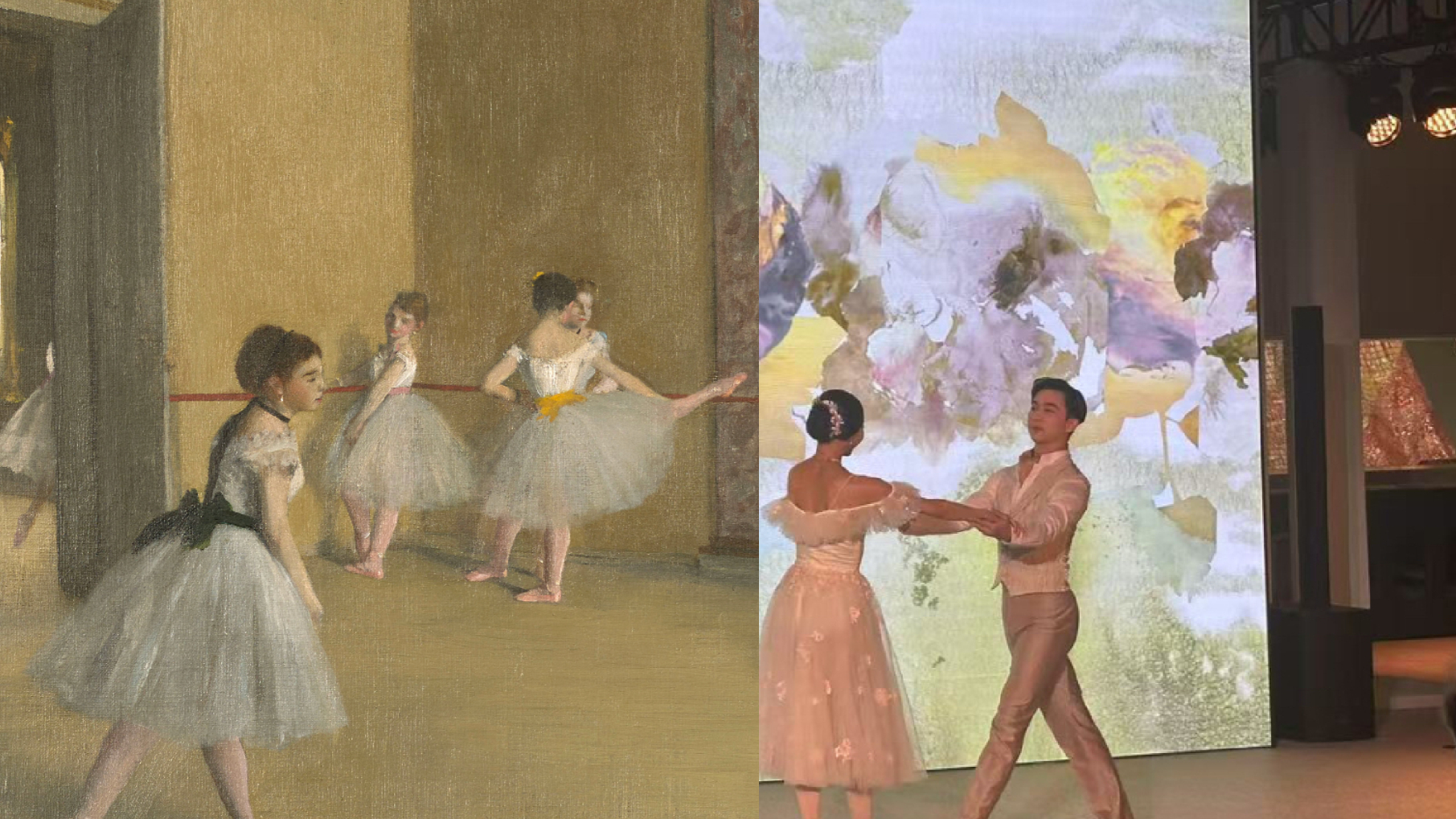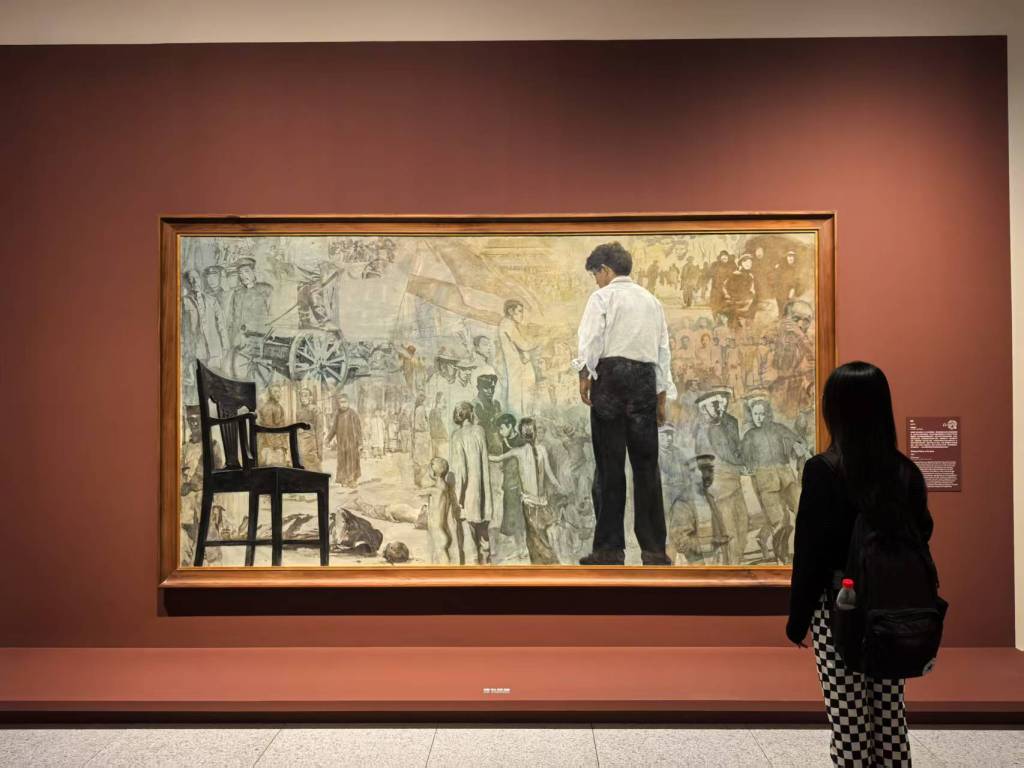
On the afternoon of June 18, the Pudong Art Museum's annual exhibition "Creating Modernity: Art Treasures from the Musee d'Orsay in Paris" opened. Works by great painters in the history of Western art, such as Millet, Courbet, Monet, Manet, Degas, Renoir, Cézanne, Van Gogh, Gauguin, and Seurat, came to Shanghai together to show the Chinese audience the transformation of Western painting from classical to modern.
At dusk at the Pudong Art Museum, dancers from the Shanghai Ballet performed a ballet selection from "La Dame aux Camélias", which corresponded to the ballet scenes painted by the famous Impressionist artist Degas in the exhibition hall. The 19th century works and the 21st century reality met on the banks of the Huangpu River.

This is an exhibition that attempts to break down the isolation of individuals and artistic genres.
Regarding the exhibition title "Creating Modernity", Sylvain Amic, president of the Musee d'Orsay, said in an interview with The Paper Art Review: "The French title for 'Creating Modernity' is 'Roads of Modernity'. 'Roads' is plural, and there is more than one road leading to modernity. Each road is a crossroads, close or far, and artists make choices and influence each other." He also emphasized that this exhibition is also the largest exhibition of the Musee d'Orsay in Asia. In the past, exhibitions were mostly focused on a certain art group or a certain art period. This time in Shanghai, "it transcends 60 years and shows the birth of modern painting."

Sylvain Amick, president of the Musee d'Orsay, speaks at the opening ceremony.

Sylvain Amick also revealed to The Paper that next year will mark the 40th anniversary of the founding of the Musee d'Orsay, and a series of events will be held to showcase its presence around the world. China is an important cultural exchange platform, and the museum will deepen its cooperation with the Pudong Art Museum in the future.

Curator Stephane Guegan gives a tour. Photo by Zhu Weihui, a reporter from The Paper
The exhibition is curated by French art historian and curator Stéphane Guégan, who was also the co-curator of the 2012 China Art Museum exhibition "Miller, Courbet and French Naturalism: Treasures from the Musée d'Orsay in Paris". Compared with 13 years ago, when the focus was on the Realist movement and its evolution, the current exhibition brings together Van Gogh's "Bedroom in Arles" and "Self-Portrait", Millet's "The Gleaners", Gauguin's "Women of Tahiti", Monet's "Haystacks in Late Summer", Manet's "Emile Zola", Degas' "Dancing Class at the Opera House, Rue Pelletier", Renoir's "Girl at the Piano", Cézanne's "Portrait of Madame Cézanne", Bonnard's "White Cat", Signac's "Woman at the Well, Op. 238", Cabanel's "The Birth of Venus" and other Orsay painting treasures. The exhibition also presents more than 20 masterpieces of sculpture, including "Victor Hugo" by Rodin, the founder of modern sculpture, as well as Degas' "Ballerina" series of bronze statues and Gauguin's wood carvings from the Tahiti period.

The Pudong Art Museum's annual exhibition "Creating Modernity: Art Treasures from the Musee d'Orsay in Paris" is on display. Photo by Zhu Weihui, a reporter from The Paper
At the opening ceremony of the exhibition, dancers from the Shanghai Ballet performed a ballet excerpt from "La Traviata", which corresponded to the dance classroom in Degar's painting in the exhibition hall.
"This exhibition is not only a tribute to these art treasures, but also an opportunity to have a profound dialogue with the times, allowing us to draw inspiration from them and feel the communication and collision between different art schools." Li Minkun, deputy general manager of Lujiazui Group and chairman (director) of Pudong Art Museum, said at the opening ceremony.

Exhibition view, Degas's "Dancing Classroom at the Opera House, Rue Pelletier" 1872

Exhibition view, Degas' ballet sculpture
Millet is the "Sower" of French Painting
Faced with so many masterpieces, you can capture works that are textbook-level in art history by just picking up your camera. However, the most well-known to Chinese audiences are Millet's "The Gleaners" and Van Gogh's "Van Gogh's Bedroom in Arles". These two works have attracted much attention when they were unpacked before, and this time they are placed in the context of the exhibition, forming another narrative.

Exhibition view, Miller's The Gleaners
Today, The Gleaners hangs quietly in the center of a small exhibition hall in the Pudong Art Museum, surrounded by works by contemporary realist artists such as Courbet and Bastien-Lepage. Unlike the idyllic and tranquil atmosphere of the work, it caused great controversy when it was exhibited in 1857. The public generally believed that Millet used this painting to protest against the difficult life of farmers (especially peasant women) at that time.

Millet, The Gleaners, 1857, oil on canvas © photo: Musée d'Orsay, Dist. RMN-Grand Palais / Patrice Schmidt
The work depicts an ancient custom - after the harvest, farmers are allowed to pick up the remaining wheat ears on the field, but this "authority" always depends on the consent of the landowner. In the picture, we can see a man on horseback supervising this process.

A man on horseback is supervising in the background of Miller's The Gleaners

The Gleaners Exhibition Hall
In the same exhibition hall, Bastien-Lepage's Hay is a direct response to The Gleaners. "Without Millet's precedent, this painting would never have been created," Stephane Guegan told The Paper. "Lepage tried to create an image comparable to Millet's work, highlighting the peasants' fatigue and their almost sluggish expressions. This is a very interesting transformation." "Although these two works are about twenty years apart, it can be clearly seen that there is a transition from Millet's 'realism' to the 'naturalism' of the French Third Republic. But what's more interesting is that Lepage was a student of Cabanel. Logically, he shouldn't have painted works on such subjects. But starting in the late 1870s, with the changes in the political situation in France, even painters trained by the academy began to turn to new subjects, especially the exploration of realistic aesthetics."

Jules Bastien-Lepage, Hay, 1877, oil on canvas © photo : RMN-Grand Palais (Musée d'Orsay) / Hervé Lewandowski
In the subsequent chapters of the exhibition, the curator buried many "easter eggs" to respond to Miller's "laborers on the land". For example, the figure on the left in Gauguin's "Two Breton Women" is a field worker; a similar image can also be seen in Emile Bernard's "Harvest Scene".

Exhibition view, Gauguin's "Two Breton Women" 1894

Exhibition view, Emile Bernard, The Wheat Harvest, 1888
"Each generation of painters has found a role model in Millet," said Guegan. "If we take this exploration a step further, Monet's Haystacks series is also a way of paying homage to Millet. Millet's appeal to Van Gogh can be said to be consistent and has never been interrupted."

Claude Monet, Haystacks, Late Summer, 1891, oil on canvas © photo : Musée d'Orsay, Dist. RMN-Grand Palais / Patrice Schmidt
Van Gogh's "Bedroom" responds to the artistic and humanistic concerns of the 19th century
In this exhibition, Van Gogh's "Bedroom in Arles" is placed in a position that is almost like a temple, just like Millet's "The Gleaners", which reflects Van Gogh's profound understanding of the "essence of realism". In the view of the curator, so-called realism is not just a superficial depiction of real things, but to express the most profound things through the most ordinary things.

Exhibition view, "Van Gogh's Bedroom in Arles"
The painting "Van Gogh's Bedroom in Arles" features extremely simple furniture and a crude bed, which is completely different from the typical bourgeois interior scenes of the time. However, Van Gogh consciously emphasized this simplicity because it has become a symbol of his artistic ideal. This bed represents "the expectation of ideal friendship" and is the place he left for Gauguin and the ideal "painter's home".

Vincent van Gogh, Bedroom in Arles, 1889, oil on canvas © photo : Musée d'Orsay, Dist. RMN-Grand Palais / Patrice Schmidt
Van Gogh had thought of inviting Emile Bernard, who was very close to him, to live in the Yellow House. Finally, under the persuasion of his brother Theo, Gauguin went to Arles. Gauguin was also a somewhat withdrawn person, and he also had doubts about Van Gogh's mental state. But he was persuaded and lived there together for several months until the famous incident happened - Van Gogh cut off part of his ear that night.

Exhibition site, photo of the Yellow House

Exhibition view, "Van Gogh's Bedroom in Arles" and Gauguin's self-portrait
Van Gogh created three "Bedrooms in Arles" between November 1888 and the summer of 1889. The one in front of you from the Orsay collection is the last one, which Van Gogh painted for his mother and sister. In this version, of the two portraits hanging on the right wall, the one on the left reminds people of Van Gogh's "Self-Portrait". Next to this "Van Gogh's Bedroom in Arles", Van Gogh's "Self-Portrait" is also hung.

Van Gogh's Bedroom in Arles (detail)

Exhibition site, Van Gogh's self-portrait
"Van Gogh's Bedroom in Arles" is a sanctuary in structure: the perspective gradually pushes upward, and Van Gogh abandons all the interest of "genre painting". "He knew that realism does not mean mechanically reproducing the everyday, but to give these things meaning, to extract symbolic connotations from the simplest objects." Guegan said, "Here, there is nothing. This is also the purity of Van Gogh - he knows how to get to the point and never talk too much. For an artist who is regarded as a madman and a pioneer of expressionism, what I hope the audience will remember is his inner clarity and restraint."

Van Gogh's Bedroom in Arles (detail)
From the simplicity and moderation of the peasant works in the "Realism" exhibition hall to the Pont-Aven School, we can see the same belief in ordinary things. In the subsequent Pointillism and Nabis, even if the theme returned to "modern life", we can still see the continuation of this spirit. For example, Signac's paintings in Provence can also be seen as a response to Van Gogh.

Exhibition site, works by Gauguin (first from left) and Bernard from the Pont-Aven School
Besides The Gleaners and The Bedroom, what other must-see movies are there?
In fact, the moment you walk into the exhibition hall on the second floor of the Pudong Art Museum, you are faced with two unexpected works with a very classical style, which also marks the beginning of the Orsay Museum's collection era.
The confrontation between Jérôme and Cabanel is a visual dialectic between academic masters, and is also a "long-cherished dream" of the curator, which has finally been realized in Shanghai. It breaks the long-standing public stereotype that "academicism equals conservatism" and makes us re-examine the innovative momentum within 19th-century French painting.

The first two works at the exhibition are Jean-Léon Gérôme's "Young Greeks Playing Cockfighting" 1846 (left) and Alexandre Cabanel's "The Birth of Venus" 1863 (right)
The exhibition hall "Manet and Zola" is one of the amazing climaxes of the exhibition, where sculptures and paintings complement each other, expressing the artist's strong obsession with capturing "movement". Here the curator mentioned "Portrait of Nina de Callias" ("Woman with Fan"). The elegant woman in the painting, wearing a Spanish-style short jacket and leaning in front of the picture, is not only Manet's close friend, but also the muse of inspiration in Mallarmé and Zola's works. "She hosted a salon, and such salon culture was extremely important in France in the 19th century, and women played a decisive role in it," said Guegan.

Exhibition view, Edouard Manet, Woman with Fan, 1873-1874

Édouard Manet, Woman with a Fan (detail)
When asked which work in the exhibition best represents "modernity", Sylvain Amick, president of the Musee d'Orsay, chose Manet's work "Emile Zola" in this exhibition hall. Zola in the painting is wearing a suit, just like modern people.
In Amick's eyes, Zola in the 19th century was not only at the center of the times, but also deeply participated in and rewrote that era through his writing and thoughts. "He is indeed a man who lived in his time. He is not only a writer, but also a social observer and a spokesperson for realism. He speaks for the grassroots and fights for the truth. He is the one who made positive contributions to social transformation. This portrait truly represents the concept of 'modernity'."

Manet, Émile Zola, 1868, oil on canvas © photo : GrandPalaisRmn (Musée d'Orsay) / Patrice Schmidt
In the painting, the book and the quill pen indicate Zola's identity as a writer, and the background is full of meaning: Manet's "Olympia", Japanese ukiyo-e, Asian screens and Velázquez's prints. "The past, foreign culture and modern art are presented in a unified way in the painting." Amick pointed out. They symbolize an open cultural attitude and also foreshadow the diverse sources of modern art.

Manet's "Emile Zola" (detail)
At the end of this hall, Monet's "Haystacks, Late Summer" is a must-see. In the eyes of the curator, this work is not only a triumph of Impressionism, but also a poetic capture of the "eternal breath of the French countryside." And Gauguin's Tahitian woman portrait, in his opinion, "seems to whisper in the ear," telling the secret language and poetry of another time and space.

Exhibition site, Gauguin's "Tahiti Women" and his sculptures
At the end of the exhibition, the curator turned his attention to Bonnard. "I have great respect for him," the curator said bluntly. In his opinion, Bonnard's importance in the early 20th century was "no less than that of Matisse and Picasso." The elongated "White Cat" shows how Bonnard used exaggeration to give shape and lyricism to the painting, giving an animal emotions, posture, and even soul.

Exhibition view, Bonnard's "White Cat"
In addition to the numerous fascinating works, this exhibition was carefully created by Cécile Degos, who took the interior of the Musee d'Orsay's iconic building as inspiration and combined it with the spatial structure of the Pudong Art Museum to restore the unique atmosphere of the Musee d'Orsay. The exhibition is decorated with the Musee d'Orsay's iconic clock in public areas, where visitors can take photos and check in, continuing the sense of immersion beyond the exhibition.

Exhibition site, Bonnard's work "Joy"
It is worth noting that in order to better serve parent-child families, this exhibition specially produced "Children's Exhibition Signs", which tell the stories of the artworks in simple and easy-to-understand language and provide a friendly viewing experience for all ages.
The exhibition will run until October 12, 2025. The "Paris 1874 Impressionist Night - Immersive Exploration Experience" will open at the same time as the exhibition. Visitors will put on VR glasses and travel back to the birth of Impressionism in 1874 during a 45-minute journey.


